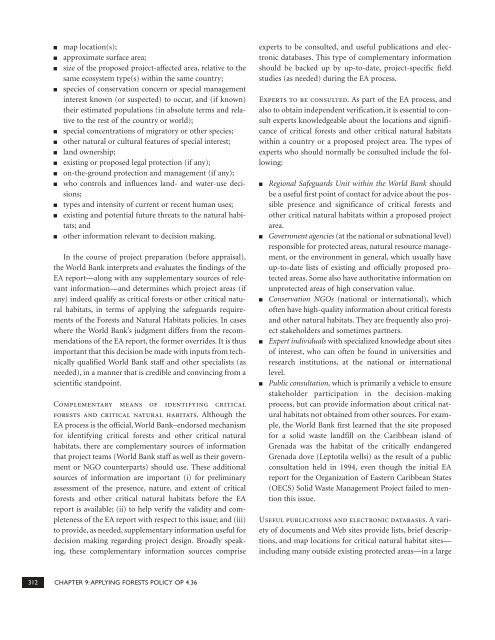Forests Sourcebook - HCV Resource Network
Forests Sourcebook - HCV Resource Network
Forests Sourcebook - HCV Resource Network
Create successful ePaper yourself
Turn your PDF publications into a flip-book with our unique Google optimized e-Paper software.
■<br />
■<br />
■<br />
■<br />
■<br />
■<br />
■<br />
■<br />
■<br />
■<br />
■<br />
■<br />
■<br />
map location(s);<br />
approximate surface area;<br />
size of the proposed project-affected area, relative to the<br />
same ecosystem type(s) within the same country;<br />
species of conservation concern or special management<br />
interest known (or suspected) to occur, and (if known)<br />
their estimated populations (in absolute terms and relative<br />
to the rest of the country or world);<br />
special concentrations of migratory or other species;<br />
other natural or cultural features of special interest;<br />
land ownership;<br />
existing or proposed legal protection (if any);<br />
on-the-ground protection and management (if any);<br />
who controls and influences land- and water-use decisions;<br />
types and intensity of current or recent human uses;<br />
existing and potential future threats to the natural habitats;<br />
and<br />
other information relevant to decision making.<br />
In the course of project preparation (before appraisal),<br />
the World Bank interprets and evaluates the findings of the<br />
EA report—along with any supplementary sources of relevant<br />
information—and determines which project areas (if<br />
any) indeed qualify as critical forests or other critical natural<br />
habitats, in terms of applying the safeguards requirements<br />
of the <strong>Forests</strong> and Natural Habitats policies. In cases<br />
where the World Bank’s judgment differs from the recommendations<br />
of the EA report, the former overrides. It is thus<br />
important that this decision be made with inputs from technically<br />
qualified World Bank staff and other specialists (as<br />
needed), in a manner that is credible and convincing from a<br />
scientific standpoint.<br />
Complementary means of identifying critical<br />
forests and critical natural habitats. Although the<br />
EA process is the official, World Bank–endorsed mechanism<br />
for identifying critical forests and other critical natural<br />
habitats, there are complementary sources of information<br />
that project teams (World Bank staff as well as their government<br />
or NGO counterparts) should use. These additional<br />
sources of information are important (i) for preliminary<br />
assessment of the presence, nature, and extent of critical<br />
forests and other critical natural habitats before the EA<br />
report is available; (ii) to help verify the validity and completeness<br />
of the EA report with respect to this issue; and (iii)<br />
to provide, as needed, supplementary information useful for<br />
decision making regarding project design. Broadly speaking,<br />
these complementary information sources comprise<br />
experts to be consulted, and useful publications and electronic<br />
databases. This type of complementary information<br />
should be backed up by up-to-date, project-specific field<br />
studies (as needed) during the EA process.<br />
Experts to be consulted. As part of the EA process, and<br />
also to obtain independent verification, it is essential to consult<br />
experts knowledgeable about the locations and significance<br />
of critical forests and other critical natural habitats<br />
within a country or a proposed project area. The types of<br />
experts who should normally be consulted include the following:<br />
■<br />
■<br />
■<br />
■<br />
■<br />
Regional Safeguards Unit within the World Bank should<br />
be a useful first point of contact for advice about the possible<br />
presence and significance of critical forests and<br />
other critical natural habitats within a proposed project<br />
area.<br />
Government agencies (at the national or subnational level)<br />
responsible for protected areas, natural resource management,<br />
or the environment in general, which usually have<br />
up-to-date lists of existing and officially proposed protected<br />
areas. Some also have authoritative information on<br />
unprotected areas of high conservation value.<br />
Conservation NGOs (national or international), which<br />
often have high-quality information about critical forests<br />
and other natural habitats. They are frequently also project<br />
stakeholders and sometimes partners.<br />
Expert individuals with specialized knowledge about sites<br />
of interest, who can often be found in universities and<br />
research institutions, at the national or international<br />
level.<br />
Public consultation, which is primarily a vehicle to ensure<br />
stakeholder participation in the decision-making<br />
process, but can provide information about critical natural<br />
habitats not obtained from other sources. For example,<br />
the World Bank first learned that the site proposed<br />
for a solid waste landfill on the Caribbean island of<br />
Grenada was the habitat of the critically endangered<br />
Grenada dove (Leptotila wellsi) as the result of a public<br />
consultation held in 1994, even though the initial EA<br />
report for the Organization of Eastern Caribbean States<br />
(OECS) Solid Waste Management Project failed to mention<br />
this issue.<br />
Useful publications and electronic databases. A variety<br />
of documents and Web sites provide lists, brief descriptions,<br />
and map locations for critical natural habitat sites—<br />
including many outside existing protected areas—in a large<br />
312 CHAPTER 9:APPLYING FORESTS POLICY OP 4.36

















